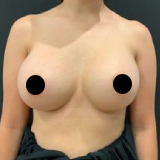This is a great question as people who had saline implants placed years ago are at an increased risk for rippling compared to patients that have silicone implants.
Silicone implants tend to have much less rippling than is typically seen with saline breast implants. This is especially true in very thin patients as that have very little breast tissue to start with prior to their breast augmentation.
There are a couple treatment options for rippling. No question the first step is exchanging your saline implants for silicone implants. The high cohesive gel implants tend to have much less rippling than saline implants. The nature of the gel makes the edges of the implant much smoother so that you don’t see the edges of the implant the same way as you do with a saline implant.
The second thing I would do is move your implants to under the muscle if at all possible (if they are not currently under the muscle). This will decrease the visible rippling on the upper portion of the breast. The muscle acts as an insulation layer to buffer the implant in both appearance and feel.
Thirdly I do like to use dermal matrix slings for patients that have very thin skin and rippling. The dermal matrix adds another layer between the skin and implant. It will reduce the visible rippling in the breast.
The combination of the silicone implants and dermal matrix tends to be very successful in minimizing rippling. The silicone will be much softer and more natural and then the dermal matrix buffers the skin to decrease the rippling.
Please discuss your breast augmentation revision surgery with your board certified plastic surgeon or contact us today.





